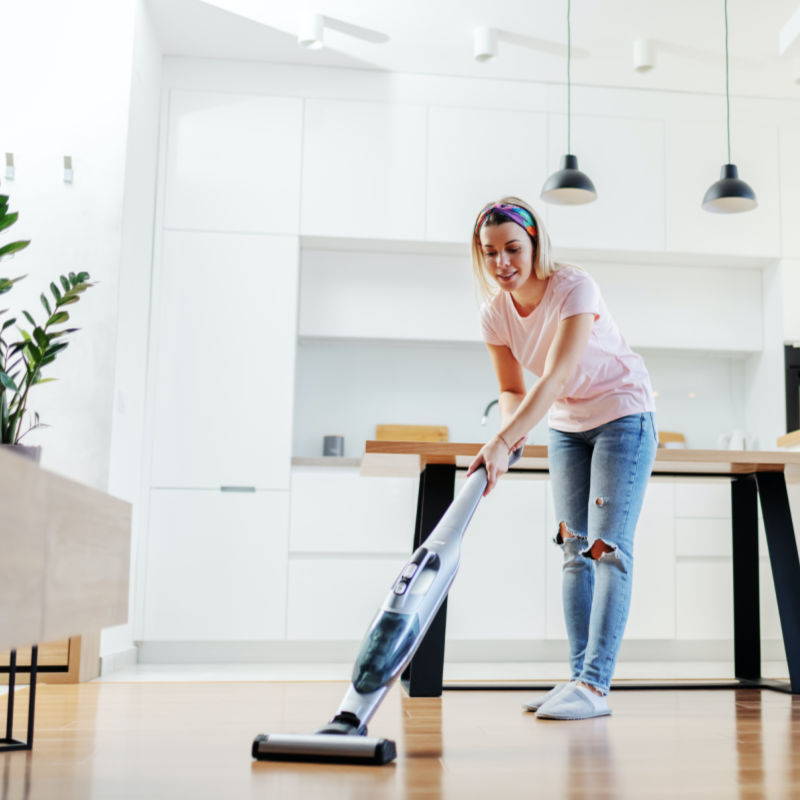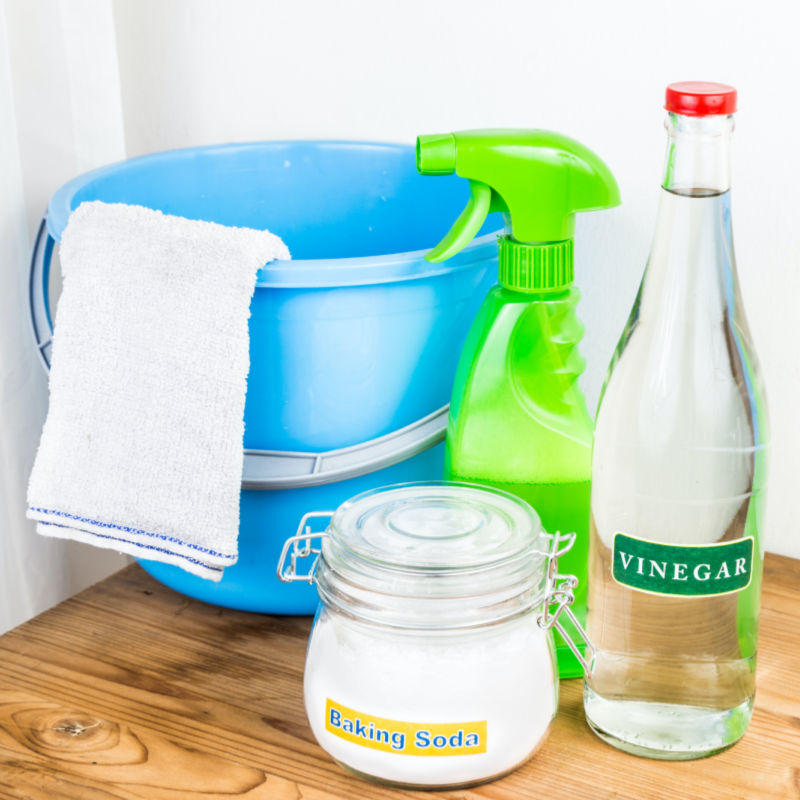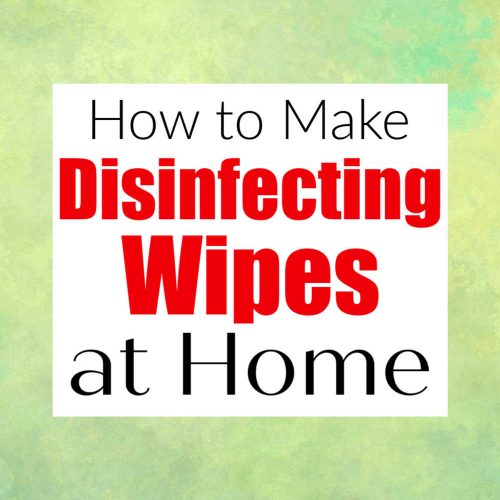It’s no wonder why linoleum floors have made a comeback recently. These stylish floors not only look good, but are timeless, funky, and full of character. The new products are nothing like Grandma’s floors. I can barely tell that some of the new products are even linoleum at all. This article will show you how to clean linoleum floors and keep them shining!

How Long Does a Linoleum Floor Last?
When linoleum is properly and regularly maintained, it is quite durable and can last up to 50 years, making it a worthwhile investment for your home’s flooring surfaces.
Take special care when cleaning linoleum, as it is made from materials such as solidified linseed oil, pine resin, ground cork dust, wood flour, and mineral fillers. Some of these materials are sensitive and can become soiled or ruined if handled improperly.
The biggest culprit for shortening the lifespan of the flooring is dirt. Small particles get caught in the texture and end up wearing the material down quickly. That is the primary reason why it is so important to learn how to clean linoleum floors thoroughly.
Advantages of Linoleum Flooring
Linoleum is one of the most eco-friendly flooring options on the market. When the time comes to replace a linoleum floor and the old flooring must be ripped up and thrown away, it will decompose entirely thanks to the all natural materials.
Linoleum floors are naturally antimicrobial, anti-static, water-resistant, and fire retardent. Although linoleum is water resistant, it isn’t water-proof. Prolonged exposure to excessive moisture or harsh chemicals will shorten its life. If water gets between the flooring and the sub-floor, it can cause mold and may cause the flooring to come loose.
Linoleum floors are pleasant to walk on because they are slightly springy with a soft underfooting. This makes them resilient and durable.
Now that we’ve given you an entirely new appreciation of linoleum, let’s dive into how to take care of it to ensure it remains as good as new for as long as possible.
How to Clean Linoleum Floors
First and foremost, linoleum floors require gentle cleaning. Too much moisture, harsh chemicals, and other aggressive cleaning practices may create irreversible damage. We don’t want that!
Linoleum Cleaning Frequency
How often linoleum floors need to be cleaned depends entirely on heavily the floor gets used. My floor is in a highly trafficked area with pets and children (and all their dirt!) traipsing on the floor daily. So, it requires more frequent cleaning. You won’t need to spend as much time keeping up with lower trafficked areas.
Clean more often if dirt, grime, food, and drinks are being tracked onto your floors. I clean mine one time per week on average.
The frequency of cleaning all really depends on how much dirt ends up on the floor. Examine your floors daily or weekly to determine how often it needs to be cleaned.
As a guideline for general maintenance and routine cleaning to keep your floors in good condition:
Cleaning Frequency
- For daily cleaning: Sweep and then use a dry microfiber cloth to remove dust and dirt on the surface. Spot clean as needed with any of the cleaning solutions provided below.
- For weekly cleaning: Use a portable vacuum with a soft bristle head to remove debris from the texture in the floor. Spot clean as needed with any of the cleaning solutions provided below.
- For monthly or periodic cleaning: Dry clean to remove any dirt and debris from the floor with a broom or vacuum. The key is to remove as much dirt and debris as often as possible to prevent the floor from becoming scratched and damaged. After removing all debris, clean the entire floor with a damp mop dipped in one of the cleaning solutions provided below or an electric steam mop. As a final step, be sure to rinse it with an additional round of clean warm water.

Best Practices for Clean Linoleum Floors
First make sure you have all the necessary supplies for cleaning. Here are the most common tools for cleaning linoleum:
- Broom
- Vacuum cleaner
- Bucket
- Dish Soap
- Mop
- Scrub Brush
- Cloths and towels
- Cleaning solution materials
Prepare for Cleaning by Following These Two Crucial Steps:
- Remove loose dust and debris from the surface of the linoleum. Sweep up or vacuum all loose dirt and debris from the floors first. If vacuuming, change the setting to “hard floor” mode which ensures good cleaning without scratching the surface. Also, make sure to clean dirt, debris, and other particles from crevices, corners, underneath fixtures and furniture, tight spaces, and any other sneaky places where dirt can hide.
- Give the entire flooring surface a thorough wipe down with a microfiber cloth. To avoid scratching the surface of the floor during mopping, it’s a good idea to give the entire surface a thorough wipe-down after sweeping or vacuuming to ensure that there are no fine particles left over on the floor.
- Microfiber 16 x 12-inch cleaning cloth (24-pack); ideal for cleaning cars, trucks, boats, and more
You are now ready for a deeper cleaning using your electric steam mop. Just make sure your floor is cleaned of any loose debris and you will keep your linoleum floors shining for years!
Natural Cleaning Solutions for Linoleum Floors
There are different types of homemade cleaning solutions to choose from. All of them are effective and gentle. It really depends on which one you prefer to use and which supplies are most readily accessible to you. These can be made safely and easily in the convenience of your own home in just minutes. There is no need to spend a lot of money buying chemicals from the store.
My favorite benefit is that they are all extremely cheap and cost effective, as big batches of each cleaning solution can be made for pennies on the dollar. The main purpose of these cleaning methods are to effectively clean your linoleum floors without the use of harsh, store bought, or chemical-laden ingredients.
Dish Soap and Water
Literally, all you’ll need to whip up this solution is some dish soap, some water, and a bucket.
Begin by adding 6-8 drops of concentrated dish soap in an empty pail. Then, fill the bucket with warm water. In total, you will probably need to use around a gallon of water. Swirl the mop around in the solution until it is saturated and soapy. Wring out the mop until it stops dripping because you don’t want to over soak the floors. Using even, gentle strokes, sweep the mop across the linoleum. After you’ve covered the entire floor, let the solution sit for ten minutes.
After you’ve completed the first round, go over the floors one more time with a clean mop with just plain water. Work backwards so you don’t create footprints or streaks. This second round of mopping without soap is imperative so that streaks aren’t left on the surface of the linoleum. After both rounds of cleaning are finished, allow the floor to air dry.
Vinegar and Baking Soda
Vinegar and baking soda is a timeless cleaning solution because it is very effective. Some variations of this method call for rubbing alcohol or hydrogen peroxide, but those variations should be considered with care because they can leave spots on the flooring or cause the linoleum to crack over time. For those sensitive to the smell of vinegar, apple cider vinegar is an equally effective alternative that leaves a more pleasant smell.

For this method, start by combining 1.5 cups of baking soda and two tablespoons of vinegar with one cup of water. Stir the ingredients until all clumps are dissolved and combined and transfer the solution to a clean spray bottle.
Spray the floor in small areas. Use a mop wetted with warm water to scrub over the area. Make sure you go over the area with a clean, wet mop a few times to pick up any leftover baking soda. You don’t want to leave any of that on the floor.
Borax and Water
Borax is an age-old cleaning method known for being an effective deodorizer. I’ll give a warning here, as Borax may not be the best choice when you have small children in the house. Here are the concerns that the CDC lists.
You can make this solution simply by mixing two tablespoons of Borax powder into 1.5 gallons of warm water. Stir the mixture thoroughly. After saturating your mop in the solution, wring it out. You want the mop damp – not soaking wet.
With your dampened mop, apply gentle pressure to soiled areas of the floor and clean in even strokes. When you’re done applying an even layer of the solution onto the floor, fill a bucket with clean, plain water. Go back over the area with a mop dampened with just plain water. This ensures that the solution is removed entirely.
- Made from anhydrous pure powdered sodium borate with no additives or preservatives.
Castile Soap and Water
Here’s an ultra eco-friendly cleaning option for you. Castile soap is plant-based and gives vinegar a run for its money for its ultra-effective cleaning capabilities. Castile soap can be purchased in bulk, and is sold in concentrated form which means it can be diluted to last longer. Usually a 32oz size bottle can last for around 6 months or so for cleaning.
To make the castile solution, pour 2 tablespoons of the soap into a bucket filled with a gallon of hot water. Dip the mop into the bucket and stir slowly until castile soap is well combined. Be sure to wring the mop out thoroughly, and then apply the mixture to your floors in even, gentle stokes.
Allow some time for the castile soap to penetrate the surface. When you have finished cleaning the entire surface, rinse out the bucket and wipe the floor clean with warm, clean water. It’s important to do this last step thoroughly because castile soap can leave behind a filmy, streaky residue.
- MADE WITH ORGANIC OILS & CERTIFIED FAIR TRADE INGREDIENTS: Dr. Bronner's Pure-Castile Liquid Soaps are made with over 70% certified organic & fair trade ingredients, promoting healthy communities, ethical working conditions & fair prices.
Steam Mop
Lastly (and this is my favorite method) is to clean the flooring using an electric steam mop. I almost always just use plain water, and skip the cleaners altogether. The combination of the hot steam and the microfiber mop pad picks up almost all dirt and dust.
I provided a review of electric steam mops if you are trying to decide which one will be best for your floor.
Tip: Make sure to still sweep up dust and debris before using the steam mop. It makes a huge difference.
Related Articles
How to Clean Linoleum Floors
Instructions
Dish Soap and Water
- Add 6-8 drops of dish soap to an empty pail
- Fill the bucket with warm water (about a gallon)
- Use the mop to mix the solution until it is saturated and soapy
- Wring out the mop until it stops dripping
- Use gentle, even strokes, sweeping the mop across the linoleum floor
- Let the solution sit for 10 minutes
- Do another round of mopping, but this time do not use a solution, just use warm water to wipe away any residue and to prevent streaking
Vinegar and Baking Soda
- Combine 1.5 cups of baking soda and 2 tablespoons of vinegar with one cup of water
- Stir the ingredients thoroughly
- Transfer solution to a clean spray bottle
- Spray the floor in small, 2' by 2' areas.
- Use a mop wetted with warm water to scrub over the area
- Make sure to go back over the area with a clean damp mop to remove any leftover baking soda. It is extremely important to leave the area clean
Borax and Water
- Mix two tablespoons of Borax powder into a bucket of warm water (about 1.5 gallons of water)
- Use your mop to combine the mixture until all the powder is dissolved
- Wring any excess moisture out of your mop and sweet in gentle, even strokes across the floor
- When you’re done applying the solution to the entire floor, do the same thing for a second round but use only warm water to wipe away any excess solution
- Let floors dry completely
Castile Soap and Water
- Pour 2 tablespoons of concentrated castile soap into a bucket filled with a gallon of hot water
- Dip the mop into the bucket and stir slowly until castile soap is combined
- Wring out the mop thoroughly
- Clean the floor in even, gentle strokes
- Complete another round but only dampen the mop with warm water
Steam Mop and Water
- Heat your electric steam mop
- Gently go over your linoleum floor in long, even strokes, allowing the steam to loosen any deep dirt or grime
- There is no need to go back over the areas, as you won't need any cleaners. The steam and microfiber pad will do the hard work for you
So, there you have it!
Cleaning linoleum effectively is simple and cheap and can be done with a variety of store bought ingredients that are combined together at home to make cleaning solutions.
Play around with the different cleaning solution options we listed here until you find the right one for your floors and your home. Some people like to add lemon juice, essential oils, and other natural cleaning aids to their mop buckets for added sparkle and shine. Feel free to create your own DIY cleaning solutions as well for your floors.







